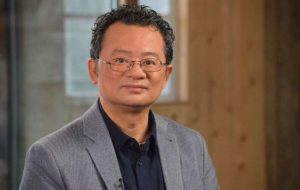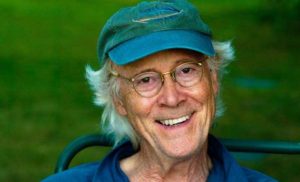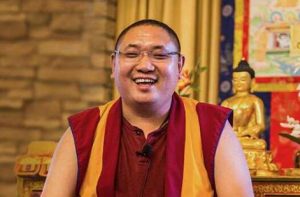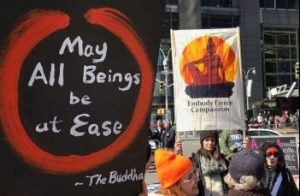
Australia’s largest stupa shines, with its bright white dome (garbhaya) and glimmering golden spire (koth keralla), like a gloriously blinding jewel in the sun-dappled Victorian outback. The Great Stupa of Universal Compassion is the subject of Ian Green OAM’s (Medal of the Order of Australia) upcoming book, Monumental: The Story of the Stupa (2023), which is due to be published in November. The book charts his connection to Buddhism, which has remained strong throughout his adult life, and the journey initiated by Lama Yeshe when he first set foot on the more than 80 hectares of bushland Green and his father donated to pave the way for the construction of the Great Stupa.
“What the West needs is more holy objects of the Dharma,” Lama Yeshe once said to Ian Green, the chairman of the organization managing the stupa and complex. What better, then, to have an example of the most ancient and revered Buddhist architecture—a stupa—in the heart of Victoria?
The power of a stupa Down Under
“The story of Australian Buddhism is actually quite a significant one, especially in today’s age of decline in formal religious belief,” Green explains. “In Bendigo, we have the oldest surviving joss house in the country, built by Chinese gold miners that had been here since the 1850s. They trekked all the way over from South Australia, where they had not been allowed to settle, to the central Victorian gold fields. More than a century later, I had been going on a spiritual odyssey of my own after a successful and pleasure-filled, but ultimately unfulfilled, career in advertising.”

Although he had always seen himself as a seeker of truth—he had explored many spiritual options when younger, and had read philosophy at university—it was not until he went to India that the trajectory of his life radically when he went to a park in Varanasi and feeling within himself a sense of peace, coming home, a new perspective. “That was the turning point,” he recalls with great fondness. Later, he would find out, it was Sarnath, the Deer Park where the Buddha gave his first sermon.
“Discovering Sarnath was life changing. When I came back to Melbourne and heard of monks from Tibet coming, it was as if I knew everything but had never heard the words. It was a real sense of déjà vu. In 1979, I went to the Foundation for the Preservation of the Mahayana Tradition (FPMT) center in the Victorian capital and met Lama Yeshe for the first time.” Green would meet the late Lama Zopa Rinpoche a few years later in 1982.
“Those were the very early days when Vajrayana Buddhist centers were being set up around the country,” recalls Green. “We had Tara House in Melbourne and Chenrezig Institute in Eudio township, Queensland. But from 1980 onward, for reasons that were not entirely certain at the time, Lama Yeshe made it clear that his vision was for a Great Stupa to be built in Australia. In 1981, my wife Judy and I moved to Bendigo to set up Atisha Buddhist Centre. After my father donated his 50 acres of bushland—I would later expand it to 200—Lama Yeshe laid out the master plan on a tour through the grounds. He identified exactly where he would build specific structures, including a hall for the lay community and a hospice. We then climbed up on this hill and he said that we would build his big stupa, complete with a big library and gompa. He told us all this in one day.”

Now with the stupa attracting regular visitors, local and tourists alike, Green acknowledges that the Great Stupa, while initially seeming an awkward fit for the Australian outback, is actually a perfect sight amid seemingly endless trees and sand. Green also emphasizes that now that the stupa has been built and made blessed through consecrations—His Holiness the Dalai Lama, the Sakya Trizin, and many others have made prayers and done pujas here—this area of Bendigo is now indeed sacred ground. “Of course, in their wisdom, the indigenous First Nations of Australia saw all of the soil as sacred from the very beginning.”
For Green, the stupa serves as a “soft” introduction to the Dharma. He noted that tourists have told him that they feel welcome and at ease when they come. They enjoy the breathtaking view, and, as they tour the grounds, feel their curiosity about Buddhism grow. This only can happen, Green stresses, if the stupa is made as accessible as a shopping mall: clean, readily available, and offering a quality experience. “The architecture reflects our reality. We want it to project a feeling of its importance in our lives, through its size and aesthetics.”
I asked what remains to be completed. Ian answers: “Currently, we are working on the gompa inside the stupa, including several six to seven-meter-tall statues. On the ceiling we have a team of 12 volunteer artists painting away at a massive, 20-square-meter Kalachakra mandala, to be completed by March 2025 for a Kalachakra initiation. On the outside, we are completing decorations of the stupa according to the Gyantse Kumbum model, working our way down each level.”

Buddhism in Australia: secularism as reality
In the second phase of our discussion, Green and I explored extensively Australia’s spiritual landscape. “Even when I was a boy, I knew lots of people that went to Sunday school, and say one thing at church but do another thing elsewhere. And this distaste for hypocrisy probably defines the current environment of disillusionment with faith in this country,” he said.
The picture is unambiguous: despite strongholds of real power and influence, “popular” religion is fading in Australian society, with 50 per cent of Australians considering themselves non-religious. And religious institutions simply no longer command the respect that they used to.
“I know that pilgrims to the Great Stupa are curious about Buddhism. It is not just Buddhists that say, ‘there is something so special about this place.’ It is coming from non-Buddhist visitors. But the secularization of society, along with many religious institutions being at the center of scandals, have taken their toll. Think of how pedophilia in the Catholic Church, along with how the covering up of these cases over the decades have damaged Australian faith in religion.”

For better or for worse, negative coverage of religious media has shaped popular opinions about certain faith groups for Australians, who on the whole are not rigorously educated in religious studies or theology. Many people have negative attitudes toward Islam because of the media’s focus on Islamic terrorism and fundamentalism. And even for the Dharma, the plight of the Rohingya and Burmese Buddhist nationalism have led to some negative perceptions of Buddhism.
“There is no way we are going to preserve and nurture the Dharma through a numbers game, through just trying to increase the number of people that take refuge in the three treasures. The reality is that in Australia, a tiny 2.4 per cent are Buddhist. Due to the nature of the demographics, that percentage is not going up; it’s plateauing and possibly going down. Encouraging more people to become specifically Buddhist is a losing battle. The only way to make a big change, to maximize good and minimize harm, is to speak in a non-jargonized, secular way.”
Green points out that Buddhists themselves point out that Buddhism goes through change and impermanence. But it is within Buddhist leaders’ power to present Buddhism in a way that is approachable to all Australians and all ages. His proposal reflects the thoughts of Lama Yeshe and Lama Zopa Rinpoche: to educate those interested in secular ethics.
“I have met many Buddhist leaders that worry about how secular ethics could water down the Dharma. Yet without the Dharma and sangha, without His Holiness the Dalai Lama and others to have even proposed it decades ago, there would be no secular ethics as we understand it today,” says Green. “His Holiness and the late Lama Zopa had the right idea: we are hoping to host events and discussions about secular ethics at the Great Stupa, and partner with institutions like Emory University. It is all about reaching out and remaining relevant.”

There are encouraging signs, like the fact that thousands of Dharma books donated from Taiwan and Singapore (traditionally, they are always free) are being taken by visitors every month. “There is a real curiosity about Buddhism in our secular society. We should embrace this potential, rather than fight losing battles.”
Buddhism’s future is an interreligious one
Despite Australians’ disillusionment with faith, Green asserts that people desperately want to believe in something. The current existential crisis of Western society, sky-high rates of depression, loneliness, alienation, and young people reporting feeling more lost and unhappy than ever, indicate that faith has left a vacuum of meaning, no matter what the secularists say. Furthermore, despite the humanist hope that one does not need religion to be good, it is hard to say with certainty that contemporary society is headed in the right direction ethically, even with advances in inclusivity such as LGBTQI rights and trans visibility. “I maintain that without faith there is no true ethics. This is a major hurdle for society, especially with alienated young people feeling nihilistic and like they can do whatever they want,” Green tells me.
Green is deeply aware of the way that the stupa leaves an impact on people that come to see it. “We can change lives and that is the whole point of the stupa.” People always say this, whether in person or on platforms like TripAdvisor,” he says. “I am always on the lookout for feedback on the Internet or face-to-face. You would not think that a stupa of this scale would work in the Aussie outback, yet the fact is that it works magnificently.”

Green says that Australia, despite an ongoing debate about its multicultural character, especially in the wake of the No vote in the referendum for an Indigenous Voice, is overall a welcoming place, and I would agree—disclosure of interests: although born in Hong Kong, I am a Chinese Australian and an associate member of the Australian Sangha Association, which supported Yes. Generally speaking, Australians are committed to multiculturalism, but many do not know how to articulate it. Multiculturalism has become politicized, and should neither be a hard-right bogeyman nor a lefty catchphrase. It should take into account multiple ways of being multicultural, one of them being interfaith harmony. Interfaith harmony is inseparable from indigenous harmony and is inseparable from national harmony.
Australia needs a place for these faiths to co-exist peacefully, regardless of that place’s faith tradition. The Great Stupa is one such place. As he put it, “We have an Interfaith Garden here, and it has a Jewish installation, a Hindu one, an Islamic and Sikh, and so on. We are working with local indigenous people for an Indigenous installation. What I love about this one has an authentic representation of a Smoking Ceremony as a welcome. The Smoking Ceremony was held by Indigenous peoples to welcome foreign visitors to Australian shores. We will have an artistic symbol of the ceremony where the visitor is introduced to Indigenous induction processes, before setting off on the path leading to the stupa.”

For dedicating much of his life to this stupa and more, Green was awarded Medal of the Order of Australia for his service to Buddhism and Interfaith Relations in 2020. His work on the Great Stupa is, however, ongoing. In his upcoming book, one can discern how different his horizon is. He was a white Australian, emerging from a “Mad Men-esque” world of 1970s and 1980s advertising corporate culture, diving into a Buddhist tradition that, at the time, was fresh and new to the Australian landscape. The younger generations that he seeks to reach out to are ethnically more diverse, and more proficient in cyberspace and social media. Buddhism no longer wields the same mystique and romance as it did before the Internet became a relentless hub of memes and disinformation.
Australia itself is a radically different country to the one he knew in his early adulthood and career. Especially in the wake of No’s victory, a decisive rejection of a proposal to recognise Indigenous people in our country’s constitution, we must see Australia for what it is, to use Buddhist parlance: a geographically Asian, not European, country still struggling with its basic identity, despite its undeniable progress. Like New Zealand, it is an island nation that sees itself as quite different to other island nations, like Micronesia and Polynesia. But is Australia not just as much at the mercy of the superpower conflict—specifically, between China and America—in the Pacific? Australia remains largely ignorant and sometimes fearful of its immediate neighbor of Indonesia, the most populous Islamic country in the world and ASEAN member, whose other constituents—many of them with large Buddhist populations—make up most of Australia’s backyard.
Given such a context in which there remains so much more work to be done, one could say that like with all things, what Buddhism seeks to assist with in Australia is really quite straightforward: the eradication of ignorance.
Monumental is due to be published in November.
See more
The Great Stupa of Universal Compassion
Platform Books
Related news from BDG
Australian Buddhists, Multi-Faith Coalition Urge “Yes” to Referendum on Constitutional Body for Indigenous Peoples
Buddhist Monastery in Australia Destroyed by Blaze
Related posts from BDG’s Tea House Blog
The Australian Sangha Association Committee’s Statement on the Referendum













